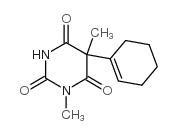2,4,6(1H,3H,5H)-Pyrimidinetrione,5-(1-cyclohexen-1-yl)-1,5-dimethyl-

2,4,6(1H,3H,5H)-Pyrimidinetrione,5-(1-cyclohexen-1-yl)-1,5-dimethyl- structure
|
Common Name | 2,4,6(1H,3H,5H)-Pyrimidinetrione,5-(1-cyclohexen-1-yl)-1,5-dimethyl- | ||
|---|---|---|---|---|
| CAS Number | 56-29-1 | Molecular Weight | 236.26700 | |
| Density | 1.225 g/cm3 | Boiling Point | 368.8ºC at 760 mmHg | |
| Molecular Formula | C12H16N2O3 | Melting Point | 145-147° | |
| MSDS | N/A | Flash Point | 176.8ºC | |
| Symbol |



GHS02, GHS06, GHS08 |
Signal Word | Danger | |
| Name | hexobarbital |
|---|---|
| Synonym | More Synonyms |
| Density | 1.225 g/cm3 |
|---|---|
| Boiling Point | 368.8ºC at 760 mmHg |
| Melting Point | 145-147° |
| Molecular Formula | C12H16N2O3 |
| Molecular Weight | 236.26700 |
| Flash Point | 176.8ºC |
| Exact Mass | 236.11600 |
| PSA | 66.48000 |
| LogP | 1.46800 |
| Index of Refraction | 1.5460 (estimate) |
| Storage condition | 2-8°C |
CHEMICAL IDENTIFICATION
HEALTH HAZARD DATAACUTE TOXICITY DATA
MUTATION DATA
|
| Symbol |



GHS02, GHS06, GHS08 |
|---|---|
| Signal Word | Danger |
| Hazard Statements | H225-H301 + H311 + H331-H370 |
| Precautionary Statements | P210-P260-P280-P301 + P310-P311 |
| Hazard Codes | Xn: Harmful; |
| Risk Phrases | R22 |
| Safety Phrases | 36/37/39-45-36/37-16-7 |
| RIDADR | UN 3249 |
| WGK Germany | 3 |
| RTECS | CQ2625000 |
| Packaging Group | III |
| Hazard Class | 6.1(b) |
|
Ozonolysis of geraniol-trans, 6-methyl-5-hepten-2-one, and 6-hydroxy-4-methyl-4-hexenal: kinetics and mechanisms.
J. Phys. Chem. A 112(29) , 6636-45, (2008) A combined density functional theory and transition-state theory study of the mechanisms and reaction coefficients of gas-phase ozonolysis of geraniol-trans, 6-methyl-5-hepten-2-one, and 6-hydroxy-4-m... |
|
|
Rabbit 3-hydroxyhexobarbital dehydrogenase is a NADPH-preferring reductase with broad substrate specificity for ketosteroids, prostaglandin D₂, and other endogenous and xenobiotic carbonyl compounds.
Biochem. Pharmacol. 86(9) , 1366-75, (2013) 3-Hydroxyhexobarbital dehydrogenase (3HBD) catalyzes NAD(P)⁺-linked oxidation of 3-hydroxyhexobarbital into 3-oxohexobarbital. The enzyme has been thought to act as a dehydrogenase for xenobiotic alco... |
|
|
Green leaf volatiles enhance methyl jasmonate response in Arabidopsis.
J. Biosci. Bioeng. 114(5) , 540-5, (2012) Plants emit green leaf volatiles (GLVs) in response to insect or pathogen damage. GLVs consist of C6 and C9 aldehydes, alcohols, and their acetate esters, and play important roles in the plant defense... |
| Methexenyl |
| Barbidorm |
| Methylhexabital |
| Evipal |
| Enhexymal |
| Hexobarbitone |
| rac-Hexobarbital |
| Hexobarbital |
| Citopan |
| 5-(cyclohexen-1-yl)-1,5-dimethyl-1,3-diazinane-2,4,6-trione |
| Cyclopan |
| 5-cyclohexenyl-N-methyl-5-methyl-barbituric acid |
| Evipan |